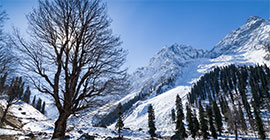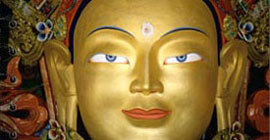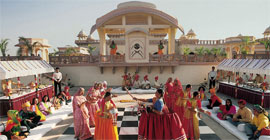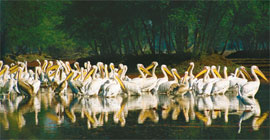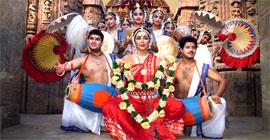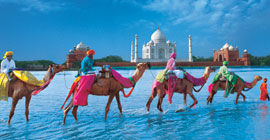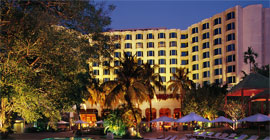VARANASI
Home | Varanasi
Ghats
The city's life revolves around its seven km long sweep of about 100 bathing ghats that skirt the west bank of the Ganges. Most of them are used for bathing. Some are used for cremating bodies. The most sacred ghats are the Asi, Dasashwamedh Ghat, Manikarnika and Panchganga. Pilgrims who bathe in each one consecutively believe their prayers will be fulfilled. A short boat trip from Manikarnika Ghat can be an interesting introduction to the river. It is believed that cremation at Manikarnika ghat ensures a safe place in Heaven, as the cremators of this ghat are believed to have the patronage of Shiva. The furthermost upstream ghat is Assi Ghat, which marks the confluence of the Ganges and the Assi rivers. It is said that after striking down demon Shumbha and nishumbha, Durga's sword fell and created a curved ditch, which later became the Assi Channel. This Ghat is one of the five special ghats which pilgrims are supposed to bathe at in sequence during the ritual route called ' Panchatirthi Yatra' ending in the Adikeshva ghat in the north. Nearby is the Tulsi Ghat, where Goswami Tulsidas lived till his death in 1623A.D. The Bachra Ghat is used by Jains and there are three riverbank Jain Temples. The Dandi Ghat is used by fakirs , yogis and ascetics and nearby is the very popular Hanuman Ghat. Dashashvamedh Ghat, Varanasi's liveliest bathing place was constructed by Peshwa Balaji Baji Rao. It's name indicates that Brahma sacrificed (medh) 10 (das) horses (aswa) here. It's one of the most important ghats and is conveniently central. Nearby is the grand Man Mandir Ghat (1637) and an observatory both built by Sawai Raja Jai Singh of Jaipur in 1710. Mir Ghat leads to a Nepalese temple, which has erotic sculptures.
BHU
BHU is the largest residential university in Asia. It has been developed as a center for education in Indian art, music, culture and philosophy and for the study of Sanskrit. The campus also houses the Bharat Kala Bhawan that has a fine collection of miniature paintings and sculptures that dates from 1st to 15th centuries. The 5-square kilometers campus of BHU, houses as many as 55 hostels. The campus has other attractions too such as the Birla Mandir that is popularly called VT. Close by is an airstrip and a flying club. The central library named Sayajirao Gaekwad Library is also worth a visit. Apart from various manuscripts and periodicals, it houses as many as 14 lacks or 1.4 million separate volumes. There is a 1000 bedded hospital too. It is called Sir Sunder Lal Hospital. Apart from concrete buildings, the campus features open spaces, greenery and peacocks, the national bird of India, which are found roaming around almost every part of the university.
Ashoka Pillar
Ashoka Pillar is at Saranath, 10km north of Varanasi. Sarnath, the place where Buddha gave his first sermon is a popular Buddhist pilgrimage centre. The Ashoka pillar stands in front of the main stupa where Ashoka sat and meditated. The Sarnath Archaeological Museum at Ashoka Marg, houses a copy of Ashoka's lion pillar and some sculptures.
Shri Kashi Vishwanath Mandir
The history of Vishwanath Temple that is also called Golden Temple at times is full of ups and downs. The temple and city has always been on the receiving end of the invaders be it Afghans, Turks, Rohila or Marathas. The temple has been built and razed to the ground several times in the history. It was first destroyed by Bakhtiyar Khilji in the 13th century and was later rebuild. Emperor Akbar donated several acres of villages to the trust that was later cut down substantially by Aurangzeb. Aurangzeb was a fundamentalist who hated every possible religion and sects in India including Sufi and Shiite order among the Muslims. Rani Ahilyabai Holkar of Indore built the present temple that stands in Varanasi, in the year 1776. Maharaja Ranjit Singh of Lahore donated the 800-kilogram Gold-plating of the towers that gives the temple its colloquial name.
Durga Temple
The Durga temple is considered one of the most important temples in Varanasi. Built in 18th century the Durga temple is stained in Red with ochre. Though the temple might have Bangla influence spiritually, it is built exclusively on the North Indian pattern called Nagara. Multi-tired spires that decrease in diameter in horizontal pattern mark this style. Actually separate spires are clubbed together one over another to give this feel. Though this style looks less attractive than the South-Indian Gopuram pattern, it has a feel of its own. Lately, people have started calling it Monkey Temple due to the menace created by the monkeys that inhabit the campus of this Temple.
Sankat Mochan Temple
Sankat Mochan Mandir do not have much historical significance but is a good place to visit at least once. Nobody knows who established this temple. It was actually very small in its early phase. In the due course various 'Mahants' collected funds to upgrade the structure and today it boasts off a fairly large complex. The temple has every possible facility for the devotees. There is an inn too where devotees can stay overnight. The must attend religious function of this temple is the famous "Pratah Aarti" or dawn offering that takes place at 5 AM in the morning. The "Sandhya Aarti" or the evening offering is performed to Lord Sankat Mochan at around 8:30 in the night. "The Rathri Aarti" is performed at around 10 PM after which the gates are closed.
Tulsi Manas Temple
Tulsi Manas Temple has a very historical as well as cultural importance for not only Varanasi but also for the whole of India. This is precisely because the place is connected to an event that still rules the Indian Psyche. The famous Hindu Epic of Ramayana was composed at this very place. Goswami Tulsi Das was the man who composed Ramayana in Hindi in the form of "Ram Charit Manas". Prior to that, Ramayana was only available in Sanskrit and that is why it was out of the reach of general masses.
New Vishwanath Mandir
Situated in the premises of Banaras Hindu University, a modern place of worship planned by Pandit Malviya and built by the Birlas. Open to all, irrespective of caste or creed.
ABC Art Gallery
This gallery is situated opposite of Tulsi Manas Mandir, Durga Kund Road. Opens from 1500 to 1900. Entry - free. This gallery exhibits the work of well-known artists of India. It gives a picture of the contemporary culture of Varanasi.
Bharat Kala Bhavan Museum
Bharat Kala Bhavan is an art and architecture museum situated inside the BHU campus. Here, one can find a large number ofBuddhist and Hindu sculptures, paintings and other materials of archaeological relevance.
This Bhavan was founded in 1920 A.D. In its main hall, there is a figure of a man standing on one leg, holding one hand on his hip and lifting a mass of stone above his head with the other hand.
It is believed that this figure is of Lord Krishna lifting Mount Govardhana. Most of the images in this Bhavan ascertain the presence of Krishna cult in Kashi during the 15th and 16th century.
Gyanvapi Mosque
Gyanvapi Mosque This mosque was built by Mughal emperor Aurangazeb. The foundation and the rear part of the mosque are the remains of a temple. One of its minarets which dominated the skyline of the holy city, collapsed in the1948 floods.
Bharat Mata Temple
The Bharat Mata temple at Varanasi is the only temple dedicated to Mother India. It is located in the Mahatma Gandhi Kashi Vidyapeeth campus. The Bharat Mata temple was built by Babu Shiv Prasad Gupt and inaugurated by Mahatma Gandhi in 1936. The statute of Bharat Mata is built in marble and is a model of undivided India, depicting the mountains, plains and oceans. The most peculiar thing about the Bharat Mata Temple is that instead of the customary gods and goddesses, it houses a relief map of India, carved out of marble.
Chunar Fort
The Chunar fort is situated 40 Km. from Varanasi. Chunar Fort, overlooking the Ganges, has had a succession of owners representing most of India's rulers over the last 500 years. Sher Shah took it from Humayun in 1540, Akbar recaptured it for the Mughals in 1575 and in the 18th century it passed to the nawabs of Avadh. They were shorty followed by the British, whose gravestones here make interesting reading. Chunar sandstone has been used for centuries, most famously in Ashokan pillars - and is still quarried, leaving the surrounding hills looking ravaged in places.
Sarnath
10 km. from Varanasi is the site where Lord Buddha preached his first sermon "Maha- Dharma-Chakra Pravartan" (in Buddhist terminology, 'turned the wheel of the law') after his enlightenment. Sarnath is one of the richest in Buddhist antiquities ranging in date from the times of Ashoka downto the 12th century A.D Ashoka built here the Dharmarajika Stupa and near it erected a pillar surmounted by the magnificent capital of four adorsed Lions, which today forms the national emblem of India.
Among other structures at Sarnath are the ruins of the brick temple representing the Mula- Gandha Kuti, ruins of stupas and monasteries. Among the more imposing ones is the Dhamekh Stupa, adorned with delicate floral carvings in the lower part, the Chaukhandi Stupa and Mahabodhi Society's Mulgandha Kuti Vihar Temple. Sarnath has also yielded an extremely rich collection of Buddhist sculptures comprising of numerous Buddha and Bodhisatva images which can be seen at Archaeological Museum, Sarnath.
Vindhyachal
There is a concept of Shaktipeeth in India. Shaktipeeth are actually places where the Goddess of power or the female part of power is supposed to be residing. The female part of Power has been named Shakti and is worshiped in the form of Goddess Durga. There are as many as 51 Shaktipeeth in India Vindhyachal is one of them. Situated at the distance of 90 Kilometers from Varanasi, Vindhyachal is worth visiting once. The place is famous for its temples namely Vindhyavasini, Asthbhuja and Kalikhoh.
Ramnagar Fort
Ram Nagar Fort and Palace Ramnagar Fort which was built in 1750A.D by the Maharaja of Banaras, is on the right bank of River Ganga. Built of red stones, it provides strength and stability to the city. Visit : Daily from 0900 t0 1200 and 1400 - 1500. It is the residential palace of the former Maharaja of Varanasi. The palace is an astronomical and astrological wonder. Inside the giant walls of the palace, there is a big clock. Besides showing year, month, week and day, it baffles the onlooker with astronomy of the sun, moon and constellation of stars. This wonder clock or Dharam Ghari was made by the court astronomer of Banaras in 1852A.D. The palace has a temple dedicated to Ved Vyas and a museum set up by the last Maharaja of Banaras, Vibhuti Narain Singh. The museum has a collection of brocade costumes, palanquins, weapons and has expensive coaches made of ivory. The palace is decorated majestically and it vibrates with colour and life, during Dussehra festival. The celebrations comes to an end on Vijayadashmi, when the huge effigies of demon king Ravana and his kinsmen are sent up in flames, signifying the victory of good over evil.
Chandraprabha Wildlife Sanctuary
Chandraprabha sanctuary is situated to the Southeast of Varanasi. Though one of India's lesser-known sanctuaries, Chandraprabha is endowed with beautiful picnic spots, dense forests, and scenic waterfalls like Rajdari and Devdari that attract a large number of tourists. The Chandraprabha sanctuary was established in May 1957. Asiatic lions were introduced at Chandraprabha in 1958. To start with the exercise was successful, with the number of lions rising from three to 11 by 1969. However, the next year the lions were found missing. The plan to put lions was again revived in 1993 but sadly not much has happened since then.







